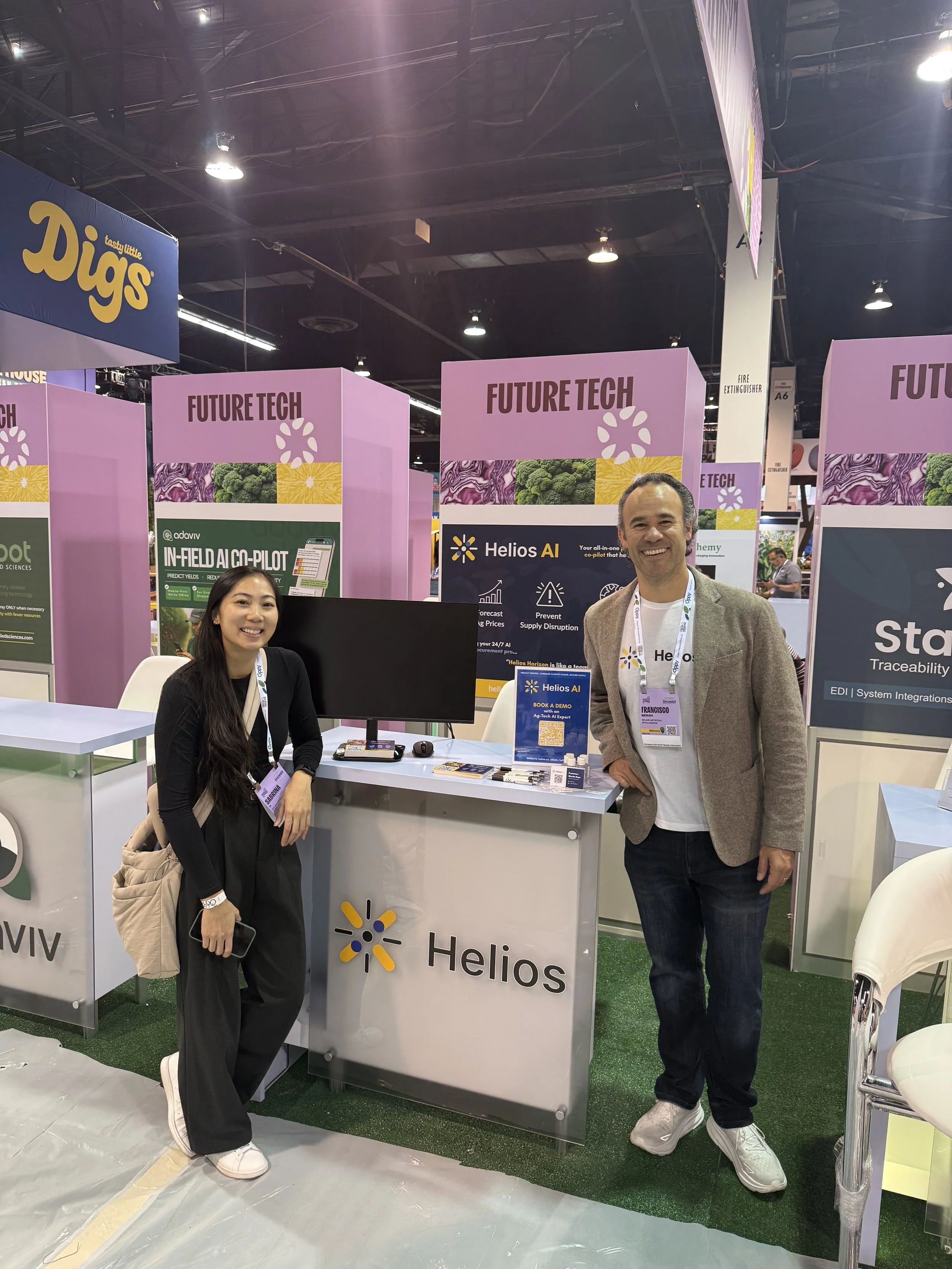Inside IFPA: How Innovation, Traceability, and Trust Are Redefining ‘Fresh'
This year’s Global Produce & Floral Show, hosted by the International Fresh Produce Association (IFPA) in Anaheim, offered a striking reflection of how the fresh-produce industry is evolving faster, broader, and more interconnected than ever.
Across more than 1,100 exhibitors representing 32 countries, one thing was clear: the future of fresh is being shaped by innovation, traceability, sustainability, and resilience, all converging at once.
Here’s what Helios noticed while attending:
1. Innovation is no longer optional
The show floor was buzzing with creative energy. To stand out in today’s market, producers aren’t just refreshing packaging; they’re reimagining entire product experiences.
At La Bonanza Avocados, for instance, the team drew crowds by blending avocado with chocolate and passion fruit, turning a savory staple into dessert. Their goal? To spark new consumer curiosity around a familiar ingredient and showcase how versatility drives growth. Over at Taylor Farms, the company unveiled its “Jalapeño Popper Chopped Kit” and “Taco Ranch Mini Chopped Kit,” expanding the concept of value-added produce through bold flavors and convenient formats.
Food produce innovation isn't just about new products anymore; it's showing a much bigger shift. It’s about rethinking how consumers experience fresh, finding the intersection of flavor adventure, nutrition, and speed.
Innovation is now the baseline expectation for competitiveness. Those who rely on “routine” will be outpaced by those who experiment.
2. Supply chain, traceability, and sustainability are front and center
If innovation dominated the show floor, traceability and sustainability dominated the conversations.
Exhibitors and buyers alike emphasized the need to track produce more precisely, manage logistics smarter, and demonstrate verifiable sustainability, not just through labels, but through transparent, data-backed systems. Braga Fresh provided one of the most compelling examples. Beyond launching new salad-kit flavors, the company hosted a tour on regenerative agriculture, introducing its “Carbon Capture Farming” program, a practical approach to turning sustainability commitments into measurable carbon outcomes.
Organizations like GLOBALG.A.P. also spotlighted how regulatory momentum is reshaping supply chains, especially under the U.S. FDA’s Food Traceability Rule, which mandates digital tracking and recordkeeping across the fresh-produce ecosystem.
As one Canadian Grocer report noted, IFPA’s 2025 theme of “Fresh Ideas” was more than a tagline; it was a call for systems change. The future of food safety, consumer trust, and brand differentiation will hinge on traceable transparency from farm to fork.
At Helios, we’ve seen the same shift play out at the systems level. The industry is starting to link environmental, economic, and logistical data into one ecosystem, creating a foundation for predictive traceability. It’s not just about where a product came from, but how its future performance and risk can be understood before it moves.
3. Growing consumer demands: flavor, convenience, and conscience
At retail, the message is clear: consumers are asking for everything, all at once. They want adventurous flavor, health benefits, ease of use, and a sense that their purchase aligns with their values. The Fresh Ideas Showcase featured more than 210 product innovations, from snack-sized fruit and resealable flow-packed vegetables to upgraded genetics like stringless peas and new bean varieties bred for both flavor and sustainability.
Companies such as Southern Specialties are expanding into bagged and convenience-ready produce while investing in organic programs and crop innovation that reduce waste and environmental impact. These trends reflect a maturing market: taste alone no longer wins. Success now depends on delivering products that satisfy curiosity, simplify daily life, and reinforce a responsible supply story—all at once.
4. The broader signal: Fresh is moving from reactive to predictive
Across these themes—innovation, traceability, sustainability, and connection—a common thread emerged: the fresh industry is transitioning from reaction to foresight.
The same mindset driving regenerative farming and traceable logistics is also driving the adoption of predictive tools, data platforms, and AI. As the climate becomes more volatile and consumers demand more complex products, the ability to anticipate, not just respond, will define market leaders.
The takeaway from Anaheim wasn’t just that the industry is innovating. It’s evolving toward intelligence, connecting the dots between what happens on the farm, in the supply chain, and at the shelf. The future of fresh belongs to those who see it as a living system, one where data, sustainability, and creativity work together to build resilience from the ground up.
Helios’ work in supply-chain foresight echoes this movement. By integrating climate and commodity data in real time, we see how the ability to anticipate, not just adapt, is becoming the new measure of strength for global food systems.
Helios AI Perspective
The conversations at IFPA underscored what many in the field already sense: the fresh-produce industry isn’t just modernizing, it’s becoming intelligent.
At Helios AI, we view this evolution through the lens of predictive supply resilience. The convergence of innovation, traceability, and data connectivity signals a future where producers, traders, and retailers can model disruption, measure climate exposure, and act faster than volatility unfolds.

